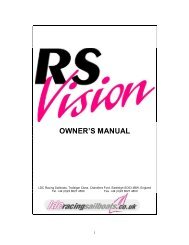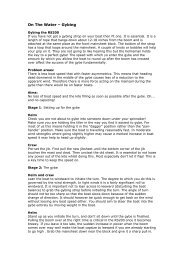rs200 owner's manual - Rs Sailing
rs200 owner's manual - Rs Sailing
rs200 owner's manual - Rs Sailing
You also want an ePaper? Increase the reach of your titles
YUMPU automatically turns print PDFs into web optimized ePapers that Google loves.
taught). Ensure the downhaul line is free to follow the spinnaker out of the<br />
chute ( you are not standing on it). Unless something becomes fouled the sprit<br />
should have precedence over the halyard as it has a 2:1 purchase advantage.<br />
Sheet in using the appropriate sheet. Check again that the halyard/downhaul<br />
is not caught and distorting the spinnaker<br />
Now treat the spinnaker virtually like a large jib.<br />
As with a jib or a conventional spinnaker for that matter pay attention never to<br />
over sheet the sail. The spinnaker sheets should be played constantly in an<br />
attempt to keep the luff of the sail just on the edge of collapse. With practice<br />
at the onset of a gust especially on a tight reach the luff of the sail can be<br />
partially rolled to help keep the boat on a level keel and travelling at her<br />
maximum speed.<br />
It is a characteristic of the asymmetric spinnaker that it will develop<br />
considerable lee helm at times particularly if the main has to be eased to any<br />
extent. For this reason it should never be necessary to raise the centreboard<br />
when reaching and is perfectly acceptable to sail the boat with a slight heel to<br />
leeward to obtain a neutral helm. The hull shape has been designed with this<br />
consideration in mind.<br />
Gybing<br />
Gybing an asymmetric spinnaker is simplicity itself but as with most<br />
manoeuvres there are a few simple tricks which can help with the efficiency of<br />
the process.<br />
They are not going to like hearing this but the helmsman holds the key to a<br />
perfect gybe! The speed with which you enter the gybe and the amount by<br />
which you allow the boat to round up after the boom has crossed over affect<br />
the success of the gybe fundamentally. Don’t bear away too quickly. Try to<br />
bear away smoothly allowing the crew sufficient time to adjust the sheets and<br />
maintaining speed. In preparing for the gybe the crew should have released<br />
the old jib sheet and set the new one loosely on the windward side then taken<br />
as much slack out of the new spinnaker sheet as possible. The crew should<br />
resist the urge to let go of or ease the old sheet too far. In fact it will help if the<br />
crew gives the old sheet a final tug in at the last moment before the boom<br />
goes over and subsequently sheets in smartly on the new sheet. Coming out<br />
of the gybe if the conditions allow the helmsman should permit the boat to<br />
round up sufficiently to fill the spinnaker as quickly as possible before bearing<br />
away smoothly to the new course. Timing is the essence and practice makes<br />
perfect.<br />
To hoist in running mode - locate the check line knot in the “V” notch and<br />
pull on the spinnaker halyard until the spinnaker has reached the top ( in this<br />
case the sheave box above the hounds). Pull on the windward sheet and set<br />
as if goose winging a jib. Setting the spinnaker goose winged on the run is not<br />
easy, it requires accurate course control and co-ordination but can have<br />
marked performance advantages particularly in restricted and tidal waters. It<br />
certainly adds another fascinating dimension to down wind tactics. The finer<br />
points of goose-winged running are still to be discovered.<br />
14




